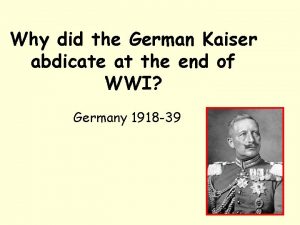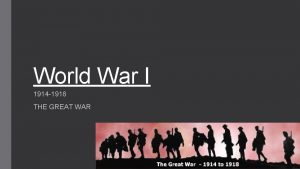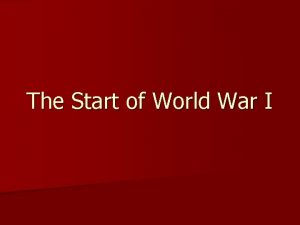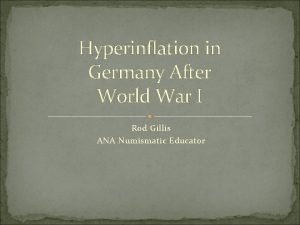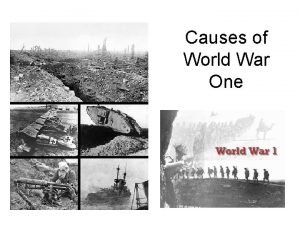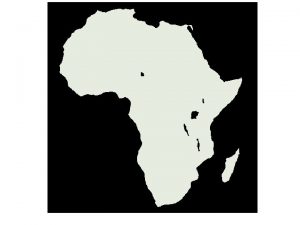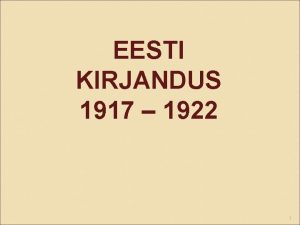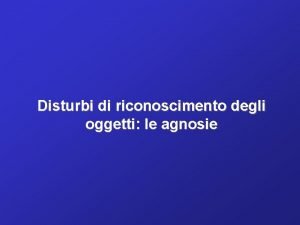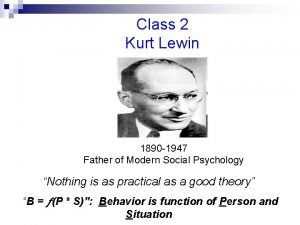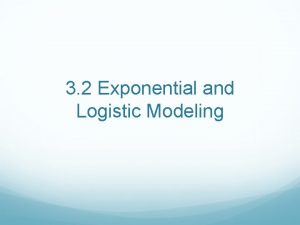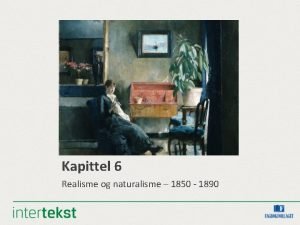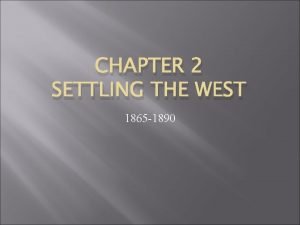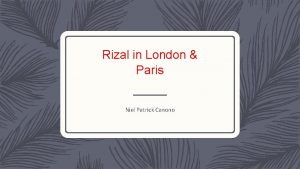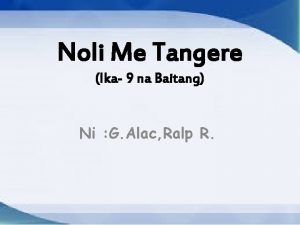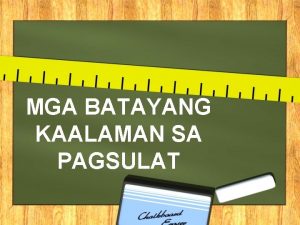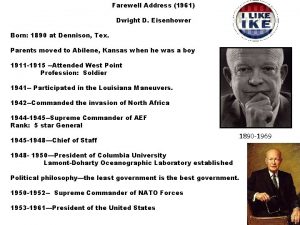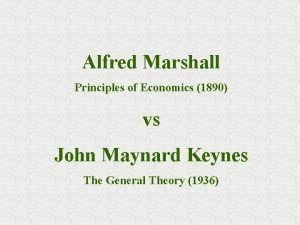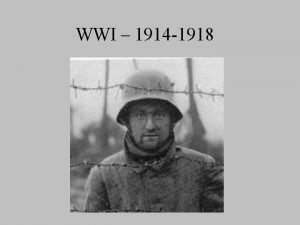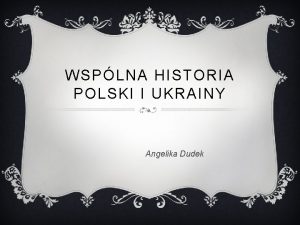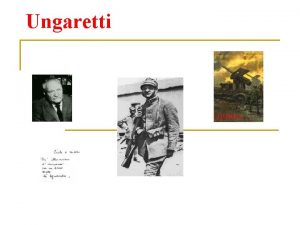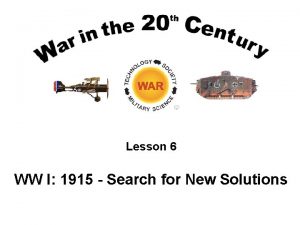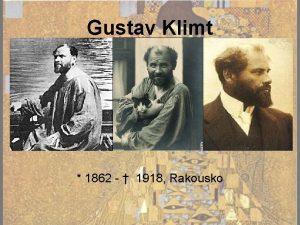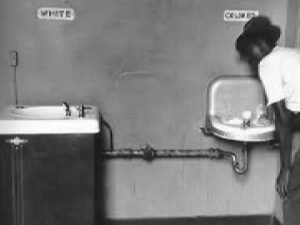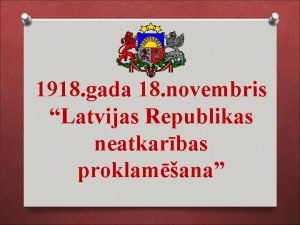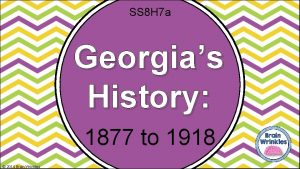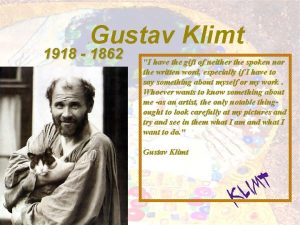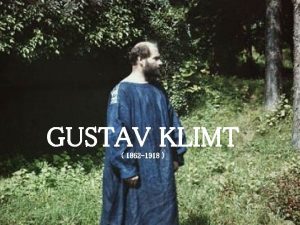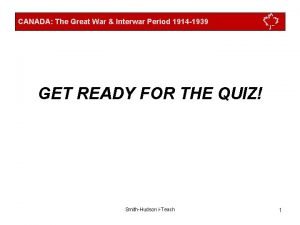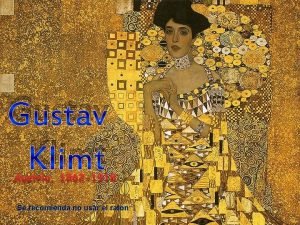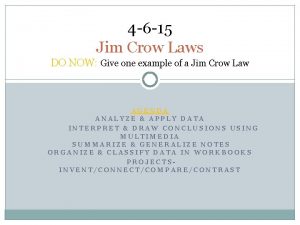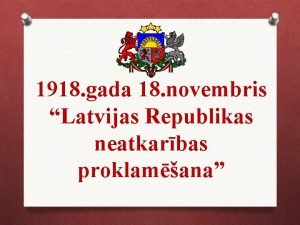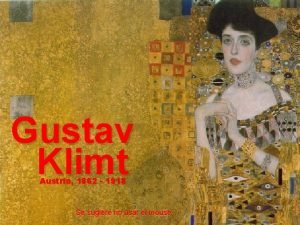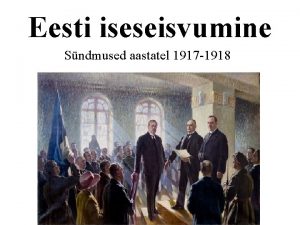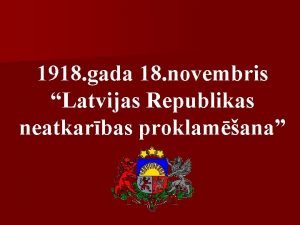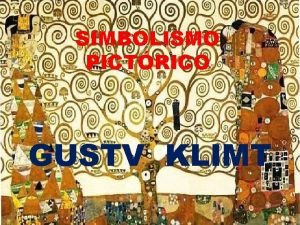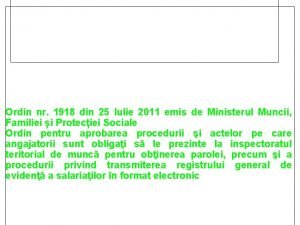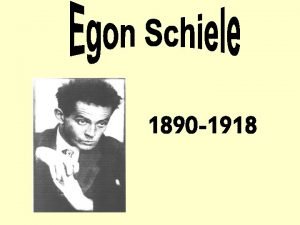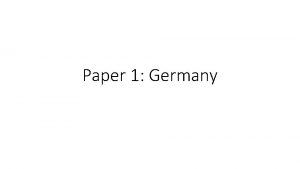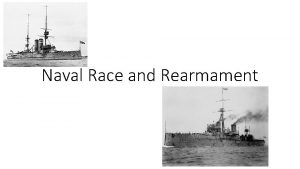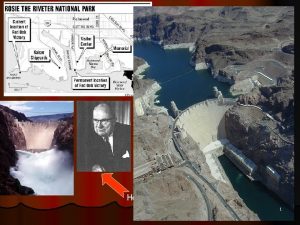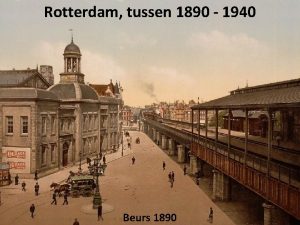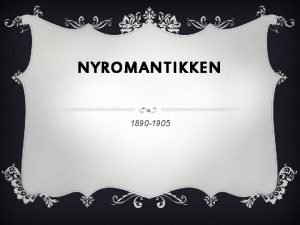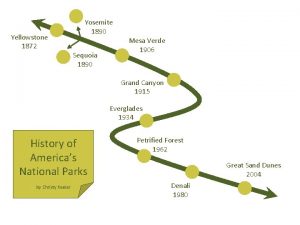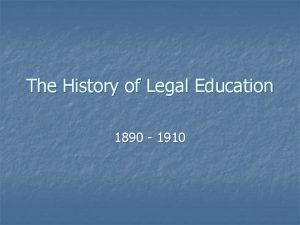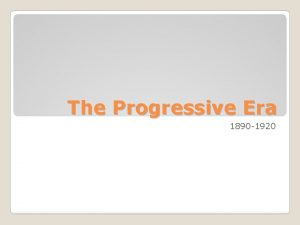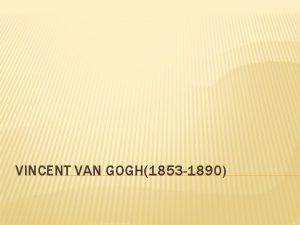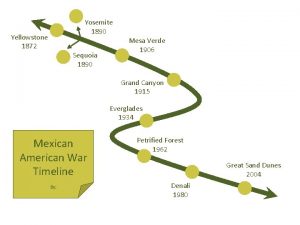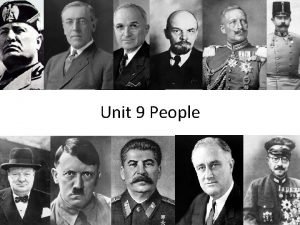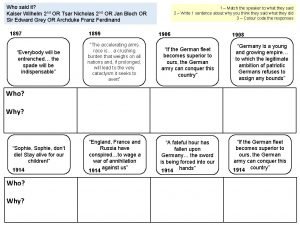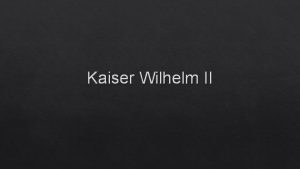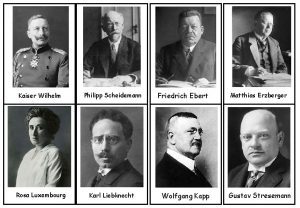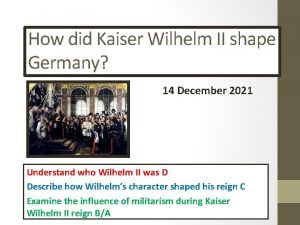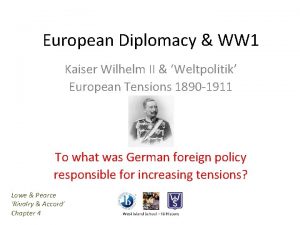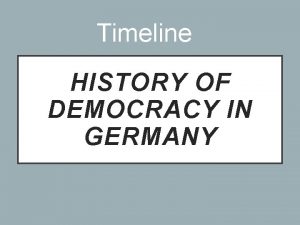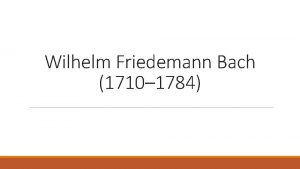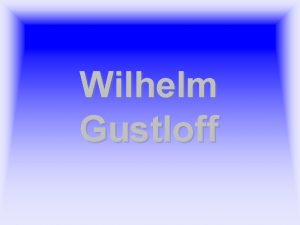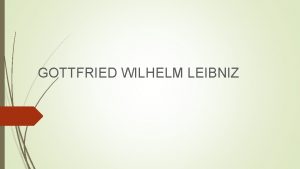Kaiser Wilhelm 1890 1918 Kaiser Wilhelm and the













































- Slides: 45

Kaiser Wilhelm 1890 -1918

Kaiser Wilhelm and the Second Reich The Second Reich: Ø Germany became a united country in 1871 The Kaiser was in charge and could appoint/ sack ministers Ø First Kaiser was Wilhelm I, King of Prussia Ø Chancellor Wilhelm appointed a Chancellor (Chief Minister) who had the power to run the country on his behalf Ø The first Chancellor was Otto von Bismark Ø The Reichstag Ø Parliament – limited power and the Chancellor could ignore it

Kaiser Wilhelm II � Kaiser in 1888 aged 29 � Queen Victoria was his grandmother � His cousin was Nicholas Tsar of Russia 1894 � He had a withered arm due to a difficult birth and suffered many ‘treatments’ as a result (EST, back & head brace, muscles cut in his neck). His doctor was English so he started to hate the English. His mother ignored him and gave attention to her other children. � He found acceptance and friendship when he joined a military school.

Wilhelm’s Aims � The Chancellor had focussed on unifying Germany � Wilhelm focussed on Weltpolitik (world policy) � Other European countries were Empire building and he wanted to too � To achieve his aims he believed Germany needed to: � Build up industry (manufacturing & factories) � Build a navy to match Britain’s � Build an army that could defeat all other powers in Europe

Wilhelm’s Problems & Solutions � Chancellors appointed by Wilhelm did not always do what Wilhelm wanted so Weltpolitik can’t be achieved � � Wanted to make Germany a world power � � Britain was the most powerful country in the world with the largest Empire, trade and navy. Wilhelm wanted to be as great as Britain and so built up Germany’s industry. He borrowed vast sums of money from rich businessmen. Rapid industrialisation and population growth � � Sack any Cancellors who won’t do as they are told (4 different Chancellors 1890 -1914) By 1913, Germany was producing more iron and steal than Britain and as much coal as Britain. It made landowners, business and factory owners very rich. However, workers were unhappy with low wages and poor working conditions whilst food was expensive. They joined trade unions and organised strikes. Formation of the SPD (Social Democratic Party) � Hoped the Kaiser would share his power with the Reichstag and make social reforms for the workers.

Naval Laws � Laws created to rival the British navy between 1898 and 1912 – the German navy rapidly increased in size. � First Naval Law 1898 � 7 battleships created (in addition to the current 12) � Second Naval Law 1900 � During Boer War with South Africa (sympathising with Boers fighting the British) � Doubled size of German navy to 38 battleships � Further � Early Laws 1900 s expanded military influence with battleships � Germany though Britain wanted to stop them having colonial power (Arms Race developed)

Impact of Naval Laws Domestic Impact � SPD and Conservatives opposed military expansion because � Taxes were increased to pay for army and navy � Money borrowed – meant debt for Germany � Highlighted the Kaiser’s obsession to succeed militarily � SPD felt the money could be spent helping the poor

Impact of WWI on Germany � Germany virtually bankrupt � � � Society divided � � � Factories producing arms for the war not to make money 60, 000 widows and 2 million fatherless children. War pensions would be expensive for the government Had lent money to allies which would not necessarily be paid back Germany had borrowed money from abroad (including the USA) to pay for the war so would need to pay the money back Some factory owners became rich during the war whilst workers had their wages restricted Women worked in the factories in the war which some Germans felt damaged traditional family values Politically unstable � � � People protested against the war due to the shortages, there was almost civil war after an SPD protest in Berlin calling for the Kaiser's resignation In November 1918, some of the Germany navy refused to board their ships Germany troops refused to control rioters There were mass strikes in Munich Ex-soldiers and civilians felt that Germany could have won the war and were betrayed by the ‘November Criminals’ who ended it and so didn’t support their new government

Weimar Republic 1918 -29

Treaty of Versailles G – Germany had to accept GUILT, blame for starting the war. Alimited– ARMEDto. FORCES limited to 100, 000 men, navy 6 battleships, 12 destroyers and no submarines. The rest of the fleet was destroyed. RGermany, – REPARATIONS – compensation payable by 136, 000 million marks (£ 6. 6 billion). G – GERMAN TERRITORY – Alsace Lorraine lost to France, Eupen and Malmedy to Belgium, West Prussia to Poland, Danzig made an international port, rich Saar coalfields to France. Total loss 13% European territory and huge natural reserves. LE – LEAGUE OF NATIONS established.

A New Constitution – the Weimar Republic The Reichstag: Ø Ø Members elected every four years by people over 20 years. Proportional Representation used (number of seats in the Reichstag depended on percentage of votes given) but there was a large number of parties so that meant no majority was met so few decisions were made The Reichsrat Ø The other parliament house, members sent by local regions and could delay new laws unless passed by 2/3 of the Reichstag Chancellor Ø Ø Head of government, chose ministers and ran the country Needed support of Reichstag to pass laws President Ø Ø Elected every 7 years, power of state, chose the Chancellor, could dismiss Reichstag, call elextions & assume control of army but took no role in day-today politics Had the power of Article 48 – suspend constitution and pass laws by decree

Spartacist Uprising � Lead by Karl Liebknecht and Rosa Luxemburg � On the 6 th of January 1919 tries to overthrow the government and create a communist state � They used the army and the Freikorps to put down the rebellion � The leader were found dead days later. In March more communist uprisings happened � It resulted in 1000 people dead

Kapp Putsch � The leader of the Freikorps, Wolfgang Kapp, tried to seize Berlin on the 13 th March 1920 � The government asked people to strike against it, this left them easy to beat � More communist uprising happened but defeated � However 2 Weimar ministers were assassinated, ? ? ?

Munich Putsch � The NSDAP was growing rapidly growing under Hitler, most of their 55, 000 party members were from around Munich � In 1923, Hitler decided to use his support ti take control of Munich and then march on Berlin, he believed he had public support due to the invasion of the Ruhr and hyperinflation � On 8 th November 1923, Hitler stormed a meeting at a beer hall in Munich and threatened the leaders of the Bavarian government with pistols so they agreed to help him, however they changed their minds the following day. � Hitler sent 3000 supporters to occupy key buildings and sent his Shock Troop to march on the town centre but they were met by the police who opened fire. 14 of Hitler’s supporters were killed and Hitler fled. � Hitler was imprisoned for treason for 5 years. He used his trial to gain publicity which gained him support, he was released after only 9 months, wrote Mein Kampf in prison outlining his political views. He realised he couldn’t take control through force and rebuilt the NSDAP to take power.

Invasion of the Ruhr � Reparations a £ 100 million a year. Couldn’t pay so France invaded the Ruhr � They confiscated raw material and manufactured goods. The workers went on passive resistance but it was met with violence � This disrupted the economy further � The government printed more money to pay their debts but this led to hyperinflation � The results of this were: everyone suffered shortages, people couldn’t buy what they needed, people with savings suddenly had nothing. Only those who had been loaned money benefitted. o o 1919 - 1 mark= £ 1 1923 - 20 billion marks= £ 1

Stresemann November 1923 Rentenmark � Based on gold reserves � Led to stability August 1924 - Dawes Plan � Reparations to increase from 1 billion to 2. 5 million over 4 years � USA loans of 800 million marks 1925 - Locarno Treaty � Between Britain, France, Italy and Germany � Agreed on the Borders September 1926 - League of Nations Permanent Seats Confirmed Germany having a power status 1928 - Kellogg-Briand Pact Germany and 64 other nations Said that armies were only for self defence 1929 - Young Plan Reduced payments from £ 6600 to £ 1850 They had to pay 2. 05 billion for 59 years

Hitler and the Rise of the Nazi Party

NSDAP � In February 1920 - 25 point programme � They brought the Volkischer Beobatcher to spread their message � Hitler suggested they change their name from the DAP to the NSDAP � Hitler became their Leader in July 1921 (pushing Drexler aside) and gathered loyal party leaders around him (Rohm, Goering, Hess & Streicher) � They then adopt the Swastika � Hitler created the SA in 1921 to provide security at meetings and break up opposition meetings � In July 1920 = 1100 members � In November 1922 = 55, 000 members

Nazi party 1924 -29 � Created branches around Germany called Guae � Ernst Rohm became the leader of the SA � They had 27, 000 members in 1925 � It exceeded 100, 000 members in 1928 � In the 1928 elections they won only 12 seats � Josef Goebbels was the propaganda leader from 1929 -33 The Nazi had: Mass rallies, posters, banners � By 1930 s Nazis owned 120 newspapers � Radio- 70% of Germans owned a radio � Planes to visit cities � � 1932, 600, 000 copies of the Nazi programme was produced � Funds from big business that was scared of communism � Used the SA to disrupt meetings � In 1931 SA had increased from 100, 000 to 170, 000

Great Depression � October 1929 the US stock market fell, they recalled their loans. This left the German government and companies poor � So they sacked workers, this left them unemployed � By January 1932 6 million people were unemployed � People were desperate and turned towards extremist parties

Presidential Election � In � � March 1930 elections there was no majority So Bruning relied on Hindenburg - Article 48 In September Nazi Party had 107 seats and were the second most popular Bruning cut unemployment benefits because the government had no money Bruning resigned in May 1932 � Election 1932 � In the first round Hindenburg failed to get over 50% of the vote � In the second round he did � However Hitler received 11, 340, 000 votes in the first round � July 1932 - won 230 seats � Largest party so Hitler demanded to be chancellor but Hindenburg elected Von Papen � Papen had no support so Von Schleicher was elected (possibly communist) � 30 Jan 1933 Von Papen and Hitler joined forces and became Chancellor and Vice chancellor

The Nazi Dictatorship 1933 -39

Reichstag Fire � 27 th February 1933 Reichstag building set alight by the Dutch communist, Marius van der Lubbe. � “Decree for the protection of People” allowed Nazis to arrest communists and suspend peoples civil rights � March 1933 won 288 seats but still need a coalition government � Enabling Act was passed but by foul means on 24 March 1933, and it was the end of the Weimar constitution and democracy � 14 th July 1933, Law against the formation of Parties which left the NSDAP as the only party � In November 1933 they won 95. 2% of the votes but 3 million were spoilt � Enabling Act meant Nazis had control over all the Laws � 2 nd May 1933 trade unions were banned and the Nazi Labour Front was set up � They also made concentration camps � They released 130 emergency decrees and centralised the

Night of the Long Knives � SS had been a key part of Nazi growth � However the Leader Ernst Rohm had too much power over SA and army � On the 30 th June 1934 four hundred people were killed � This included Rohm and Von Scheilcher � SA was absorbed by the SS and army � They had previously had loyalty to Ernst Rohm � In August 1934 Hindenburg Died � The army swore a oath of Loyalty to Hitler � 90% of Germany agreed with his actions

Control SS and Gestapo � run by Himmler � By 1934 the SS had 55, 000 members � The Gestapo wore plain clothes and could arrest and imprison anyone they suspected to opposing the state � By 1939, 160, 000 people were arrested for political crimes October 1933 the German Lawyers Front was set up. � It immediately had 10, 000 members � In 1934, the People’s court was set up to try cases of treason � By the end of 1934 Hitler controlled the army and the legal system Concentration Camps The SA and SS ran them. They arrested: ØJews and Black people ØProfessional Criminals ØForeign Forced Labour groups ØReligious groups ØSex offenders ØPolitical prisoners ØWork shy ØDisabled

The Church Catholics � Almost a third of Germans were Catholic � Catholic had 1 st allegiance to the Pope not Hitler. Also they had catholic schools and youth groups � He signed the concordat in July 1933 protecting Catholic � In a few months later he arrested priests, abolished catholic schools, closed youth movements and closed monasteries Protestants � Leader was Reich-bishop Ludwig Muller, September 1933 � They praised Hitler and Mein Kampf � However many protestants opposed Nazism � Pastor Niemoller set up the Confessional Church against Hitler. He was arrested in 1937 and the confessional was banned

Propaganda & Censorship Rallies- An annual rally was held at Nuremburg to show the power of the Nazis. Local rallies were run by the SA Radio- The Nazi mass produced cheap radios so the whole nations could hear Hitler speak Posters- They cleverly used posters to put across the Nazi message and ideologies especially targeted at the young Newspapers- All papers were owned by the Nazis and editors were told what they could print Books- May 1933 20, 000 books were burnt because they were Jewish or anti-Nazi Cinema- The Nazi produced 100 films a year, which in 1933 250 million people saw. All films started with Nazi messages

Culture Music � banned jazz because it was too black. Encouraged German folk music and Bach or Beethoven Theatre � concentrated on German history and political dramas. The tickets were cheap to encourage people to watch them Art Ø all modern art was banned because it was ‘backward and Jewish’. Traditional only Olympics Ø The games were designed to impress the world, with the modern and well organised society Ø Jesse Owens who won 4 gold medals and broke 11 Olympic records

Nazi Domestic Policies 1933 -39

Controlling the Young Teachers � swear an oath of loyalty and join the Nazi teachers league Textbooks � Were rewritten to fit the Nazi view. Mein Kampf was a regular text Lessons � Began and ended with “Heil Hitler”. Curriculum � 15% was devoted to sport. Girls took needlework and cookery. They introduced race studies Hitler Youth � Hitler youth for boys between 14 -18. They were prepared for the army by camping, athletics, marching and map reading � From 1936 membership was compulsory � By 1939 there were 7 million members � The League of German maidens did the same as the HY except they also did domestic skills and motherhood

Women Change Weimar Women Nazi Women Politically Women over 20 had the vote. By 1933 10% of the Reichstag was female Women were to have no interest in politics Economically Many had careers in teaching, medicine and in the civil service. Plus the civil servants earned the same as men. By 1933 100, 000 women teachers and 3000 doctors Women would be mothers and homemakers. If they did work they earned considerably less than men Socially Women went out unescorted. They smoke and drank in public. They were slim and fashion conscious. They had short hair and wore makeup Women were always escorted. They would never smoke, drink or diet. They would have hair in a bun and would not wear make up

Women � 1933 the Law for encouragement of Marriage meant loans were given to new couples � Medal were given out on 2 nd may � In 1938 the divorce Law changed � Lebenborn was set up and the German’s Women’s Enterprise � From 1937 onwards women were forced to work a ‘duty year’ because of rearming

Reducing Unemployment Job creation schemes- Spent 37 billion on it in 1938. They subsided the construction industry. They introduced the building of the autobahns Invisible unemployment- Jews taken from there jobs, unmarried men sent to the Labour service Corps, Women dismissed from jobs for homemaking and opponents of the Nazis held in concentration camps Rearmament- introduced conscription in 1935, army had 1. 4 million men in 1939. Heavy industry expanded. This meant coal and chemicals doubled in 1933 -39. Billions was spent creating tanks, aircraft and ships. This gave people more jobs

Better off under the Nazi’s � Strength through joy – organisation to replace the trade unions. It organised holidays and day trips for workers. They were low cost so ordinary workers could afford them � Beauty of work- this improved working conditions i. e. by better lighting � Volkswagen- scheme for people to save 5 marks a week for a car � Wages- average wage rose from 86 marks in 1932 to 109 marks in 1938

Worse off under the Nazi’s � Lack of freedom- trade unions were banned so workers couldn’t negotiate for better wages � Strength through joy – hardly any workers could afford the holidays � Volkswagen- By the time the war broke out not one person had a car, and their money wasn’t refunded � Cost of living- all groceries cost more in 1939 compares to 33. This is because food was in short supply, the was to keep farmers benefits � Hours of work- increases from 42. 9% of the week to 47% in 1939

Jewish persecution April 1933 - Boycott of Jewish Shops The SA painted ‘Jude’ on Jewish shops and urged people not to enter 1934 - Ban on Public Places Jews could not enter public parks, fields and swimming pools May 1935 - No army Jewish people banned from the army September 1935 - Nuremburg Laws Jews weren’t citizens, they could not vote and could not marry a German (Law for protection of German blood) 1936 - nothing because of the Olympics March-October 1938 Register possessions , carry identity cards, star of David on their clothes, add ‘Israel’ or ‘Sarah’ to their names, stamped ‘J’ on their passports Kristallnacht 8 th November 1938, a polish Jew kills a Nazi official in the German embassy in Paris 9 th-10 th Jewish shops, homes and synagogues were smashed up 91 Jews died and 20, 000 sent to concentration camps They are fined 1 billion marks and are not allowed to run business’ or send their children

Other groups Sterilisation Law- Passes in July 1933 allowed the Nazis the sterilise alcoholics and disabled people Concentration Camps- was were the locked up prostitutes, homosexuals, juvenile delinquents, gypsies, tramps and beggars Euthanasia campaign- in 1939 the Nazis secretly began to kill mentally ill people. Around 6, 000 disabled babies, children and teenagers were murdered by starvation or lethal injection

Germany in WWII 1939 -45

Youth Rebellion � Gangs appeared that played their own music and boys and girls were free to be together. � They grew their hair long and wore their choice of clothes. They even beat up members of the HY � The Edelweiss pirates Helped army deserters, forced labourers and escaped concentration camp prisoners � Distributed anti-Nazi leaflets � Ignored at first but then many arrested and several publically hanged � � Swing Kids (or Swing Youth) Rebelled against tight control of Nazis � Acted in ways Nazis considered degenerate – listened to American music and drinking alcohol �

Church Opposition � Little opposition from Christian groups but some members did opposed them � Martin Niemoller Protestant pastor who objected to Nazi interference in the Church � Founded the Confessing Church � Used a sermon to protest against the persecution of the Church in 1937 and so was sent to a concentration camp � � Dietrich Bonhoeffer Protestant philosopher and pastor � Joined the resistance, helped Jews escape Germany and planned to assassinate Hitler � Caught, imprisoned and executed � � Clemens August von Galen Catholic Bishop of Munster who used sermons to protest against Nazi racial policies and the murder of the disabled � Protests made Nazis keep the killings a secret � Not executed as Nazis needed support of German Catholics �

Germany’s War Economy Preparation for War � Four-Year-Plan in 1936 – building up of industries making weapons, chemicals and increasing agricultural output � Hermann Goring in charge of economy aiming to make Germany selfsufficient (not needing imports) � Workers retrained to do jobs to help with war effort � Hitler knew they needed new territories and resources to become properly self-sufficient Outbreak of War � Germany wasn’t ready for war in 1939 � ¼ of the workforce was already in war industries, this was ¾ within 2 years � German workers were conscripted into the army so foreign workers were used to keep the economy going (civilians in occupied territories, prisoners of war, slave labourers, etc. ) � Albert Speer put in charge of war economy in 1942 � � � Focussed completely on the war effort Improved efficiency and increased weapons production Used raw materials from occupied lands

Germany’s War Economy � Daily Life � Wages decreased to less then before the Nazis took control � Working hours increased � Rationing Food & clothes from 1939 � Whilst Germany winning the war, most goods could be bought easily � By 1942, German civilians living on rations of bread, vegetables and potatoes (decreased as war went on – much less than British rations) � � More women and children had to work after 1941 (due to heavy defeats in Russia), by 1944 50% of the workforce were women/

Impact of War Total War � Between countries economies, scientists, industries and civilians � All resources had to be directed to the war effort Civilian clothes and consumer goods no longer manufactured � Food rations highly restricted � More women expected to work and join the army � Makes aged 13 -60 who weren’t in the army had to join the Volksstrum (part-time defence force) � � Bombings Community air raid shelters made � Auxiliary hospitals and emergency first-aid stations established � Half a million Germans were killed in the bombings and more made homeless � Germany struggled to deal with the growing refugees from bombed cities �

Growing Opposition Kreisau Circle � Led by Helmuth von Moltke & Yorck von Wartenburg � Against violence so discussed how to make Germany better after the Nazis � Informed Allies about the dangers and weaknesses of Nazi control � Members (including Moltke) were arrested and executed in 1944 Rosenstrasse Protest � Authorities rounded up the last Jewish men in Berlin – many married to ‘Aryan’ women � The wives went to the building where the men were being held in Rosenstrasse (Rose Street) to protest for days � Eventually Goebbels ordered the release of the men Underground Networks of Communists � Gathered information about Nazis and distributed leaflets

Growing Opposition White Rose Group � Students & lecturers at Munich University including Hans and Sophie Scholl � Used non-violent methods to protest against Nazi discrimination � Many were arrested, tortured and executed, including Hans and Sophie Scholl Army Resistance � July Plot 1944 – Claus von Stauffenberg and German officers planned to kill Hitler and replace him with a moderate government � Stauffenberg left a bomb in a briefcase by Hitler’s chair. Someone moved the suitcase so when the bomb exploded, Hitler was unhurt. � Most of them were arrested and executed
 Why did the kaiser abdicate?
Why did the kaiser abdicate? What is shell shocked
What is shell shocked Kaiser wilhelm deformity
Kaiser wilhelm deformity Did kaiser wilhelm have a withered arm
Did kaiser wilhelm have a withered arm Militarism definition
Militarism definition Old imperialism vs new imperialism chart
Old imperialism vs new imperialism chart Kirjanik 1898-1978
Kirjanik 1898-1978 Riconoscimento degli oggetti
Riconoscimento degli oggetti Father of social psychology
Father of social psychology 1890'lı yıllarda ingiltere'de whiff
1890'lı yıllarda ingiltere'de whiff The population of smallville in the year 1890 was 6250
The population of smallville in the year 1890 was 6250 The population of smallville in the year 1890 was 6250
The population of smallville in the year 1890 was 6250 Et dukkehjem realistiske trekk
Et dukkehjem realistiske trekk 1890 computer
1890 computer Settling the west 1865-1890
Settling the west 1865-1890 English city fight against
English city fight against Saan nalimbag ang el filibusterismo
Saan nalimbag ang el filibusterismo Ang pagsulat ay isang pakikipag-usap sa mga mambabasa
Ang pagsulat ay isang pakikipag-usap sa mga mambabasa Born 1890
Born 1890 August 1891 el filibusterismo
August 1891 el filibusterismo Keynes marshall
Keynes marshall Map of europe in 1918
Map of europe in 1918 Angelika dudek
Angelika dudek Figure retoriche soldati
Figure retoriche soldati Varför kallas perioden 1918-1939 för mellankrigstiden
Varför kallas perioden 1918-1939 för mellankrigstiden 3.7 cm tak 1918
3.7 cm tak 1918 1918-1862
1918-1862 Louisiana 1918 poll tax receipt
Louisiana 1918 poll tax receipt 1918 18 novembris
1918 18 novembris Red scare
Red scare Georgia history timeline 1877-1919
Georgia history timeline 1877-1919 Proiect didactic 1 decembrie clasa 3
Proiect didactic 1 decembrie clasa 3 1918-1862
1918-1862 1918-1862
1918-1862 1914 1918
1914 1918 1918-1862
1918-1862 Louisiana 1918 poll tax receipt
Louisiana 1918 poll tax receipt 1918 18 novembris
1918 18 novembris 11 listopada 1918 piosenka tekst
11 listopada 1918 piosenka tekst 1918-1862
1918-1862 Eesti iseseisvumine 1918
Eesti iseseisvumine 1918 1918 18 novembris
1918 18 novembris 1918-1862
1918-1862 Joodse organisatie ci
Joodse organisatie ci Ommfps 1918/2011
Ommfps 1918/2011 Lịch sử hà nội từ năm 1802 đến năm 1918
Lịch sử hà nội từ năm 1802 đến năm 1918
